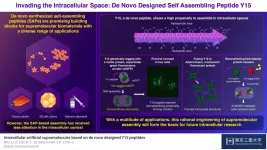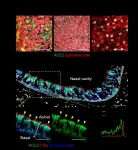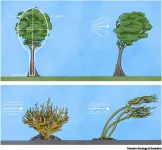In a supramolecular realm: Advances in intracellular spaces with de novo designed peptide
2021-07-01
(Press-News.org) Over the last two decades, biomaterials research has made significant progress, transitioning from traditional biomaterials to biomaterials with controlled structure and dynamic functionality. A number of building blocks have been explored for developing biomaterials by self-assembly, but SAPs have garnered special attention due to their tunability and potential use in various applications such as tissue engineering, wound healing, and vaccinations. Despite these benefits, the SAP-based approach is less explored in the intracellular context.
Fortunately, a team of scientists from the Tokyo Institute of Technology (Tokyo Tech), led by Assistant Prof. Takayuki Miki, have reported a de novo peptide, Y15, that readily forms secondary structures to enable bottom-up synthesis of functional protein assemblies in live cells. Their findings are published in Nature Communications. Assistant Prof. Miki explains, "The cell environment is a dense milieu in which macromolecules occupy a considerable volume; developing SAPs that interact in such a crude setting is difficult. Thankfully, we were able to create a de novo peptide--that is, from scratch--which shows a high propensity to assemble in intracellular spaces."
To leverage the self-assembling propensity, the scientists designed and synthesized four variable length Yn peptides--Y9, Y11, Y13, and Y15--as well as the negative control peptide Y15(K9P). Y15 clearly outperformed the others and self-assembled rapidly at low buffer concentrations, creating β-sheet structures. Y15 forms an amphiphilic β-strand with a hydrophobic face composed of tyrosine (Tyr) residue and a hydrophilic face composed of alternating glutamic acid (Glu) and lysine (Lys) residues. Thus, neighboring β-strands can connect through hydrophobic and aromatic interactions between Tyr residues as well as electrostatic interactions between negatively charged Glu and positively charged Lys residues.
The scientists realized that Y15 could be a key motif in the formation of protein assemblies in a liquid solution. To evaluate the assembly mechanism, Y15 was genetically tagged with a model protein, superfolder green fluorescence protein (sfGFP). They discovered that it could form fibrous structures in test tubes. Furthermore, when Y15-sfGFPs were expressed in live cells, they retained their self-assembling affinity by forming clusters. Several tests corroborated the clustering of Y15-sfGFP in live cells, confirming that these peptides can facilitate protein assembly.
The researchers were also able to build artificial microscale structures by fusing Y15 to Azami-Green, a tetrameric fluorescent protein. Thus, Y15-based assemblies could be adorned with functional proteins as well. Further, the researchers reconstructed Nck (an adaptor protein) clusters by incorporating Y15-tagged Nck into Y15-based supramolecules. This resulted in N-WASP (neural Wiskott-Aldrich syndrome protein)-mediated actin polymerization, which in turn plays an integral role in cell locomotion. The Y15-based assembly helped in evaluating the impact of Nck domain valency and density-dependency, hence serving as a platform for in-cell reconstitution studies.
The Y15 SAPs are much smaller than previously reported protein-based tags. Likewise, the use of an SAP-based system is sensible and straightforward, and it can be genetically tagged to optimize functioning. Assistant Prof. Miki concludes, "We believe that SAPs will set the stage for a range of applications, such as cluster formation with stimuli responsiveness, artificial constitution of phase separations, reconstitution of natural protein complexes, and many more. We hope that this rational engineering of supramolecular assembly will pave the way for future intracellular research."
We sure have our fingers crossed!
INFORMATION:
[Attachments] See images for this press release:

ELSE PRESS RELEASES FROM THIS DATE:
2021-07-01
Boulder, Colo., USA: The Geological Society of America regularly publishes
articles online ahead of print. GSA Bulletin topics include
multiple articles about the dynamics of China and Tibet; the end-Permian
terrestrial extinction paradigm in South Africa; prehistoric lava flows
from the urban district of Catania (Etna volcano, Italy); the debated
origins of granite, and "a tale of two Tweefonteins." You can find these
articles at
https://bulletin.geoscienceworld.org/content/early/recent
.
Authigenic berthierine and incipient chloritization in shallowly ...
2021-07-01
Most babies born prematurely or with health problems are quickly whisked away to the Neonatal Intensive Care Unit (NICU) where they might require assisted heating devices to regulate their temperature. A University of Houston College of Nursing researcher is reporting that the traditional use of cloth blankets and towels during peripherally inserted central catheter (PICC) placement may hinder heat transfer from the assisted heating mechanisms, increasing the risk for neonatal hypothermia. In Advances in Neonatal Care, Huong (Kelle) Phan, clinical assistant professor, reports that a plastic drape lowers the incidence of hypothermia.
"The use of the plastic drape is a quality improvement to reduce the hypothermia rate in very low birth-weight ...
2021-07-01
WILMINGTON, Del. (June 29, 2021) - A new report finds that 509,025 (9.17%) public high school students in 24 states experienced homelessness in spring 2019 -- three times the number recognized by the states' education agencies. This under-recognition creates gaps in funding and services needed by this vulnerable population.
Researchers from Nemours Children's Health and the University of Pennsylvania analyzed data from the Centers for Disease Control and Prevention (CDC) for public schools across 24 states and 12 school districts. During spring 2019, more than 9% of public high school students experienced homelessness during a 30-day period in the 24 states. The rate was even higher in the 12 school ...
2021-07-01
New research published today in the journal Blood Advances finds that certain factors, such as a history of severe pain episodes and coexisting organ conditions, increase the risk of severe COVID-19 illness, including hospitalization, in individuals living with sickle cell disease (SCD). According to researchers, the study results underscore the need for COVID-19 risk reduction strategies and vaccination for this medically vulnerable population.
SCD is the most common inherited red blood cell disorder in the United States, affecting an estimated 100,000 people. According to the Centers for Disease Control and Prevention, SCD affects one out of ...
2021-07-01
Understanding how viral infection occurs can provide important clues for researchers to develop strategies to prevent viral transmission and develop effective therapeutic agents and vaccines. SARS-CoV-2, the causative agent of COVID-19, enters the host cells through interaction between the virus's spike protein and the extracellular receptor binding domain of ACE2. The viral entry into the cells is completed by various proteases, which allow the viral and cell membranes to fuse together. While it is known that the upper respiratory tract becomes compromised in the early infection, the exact types of the cells that the virus infects at the earliest stage have not yet been identified.
Led by Director ...
2021-07-01
New research from the Institute of Psychiatry, Psychology & Neuroscience (IoPPN) at King's College London, in collaboration with the University of Liverpool and the Karolinska Institute, has shown that many of the symptoms in fibromyalgia syndrome (FMS) are caused by antibodies that increase the activity of pain-sensing nerves throughout the body.
The results show that fibromyalgia is a disease of the immune system, rather than the currently held view that it originates in the brain.
The study, published today in the Journal of Clinical Investigation, demonstrates that the increased ...
2021-07-01
Extreme differences in flight altitude between day and night may have been an undetected pattern amongst migratory birds - until now. The observation was made by researchers at Lund University in Sweden in a study of great snipes, where they also measured a new altitude record for migratory birds, irrespective of the species, reaching 8 700 metres.
Great snipes are shorebirds that breed in Sweden, among other places, and spend the winter in areas near the equator in Africa. Previous studies have shown that great snipes make long marathon flights of up to 6 000 kilometres lasting 60-90 hours when they migrate between breeding sites in Sweden and wintering ...
2021-07-01
Chatbots have already become a part of our everyday lives with their quick and intuitive way to complete tasks like scheduling and finding information using natural language conversations. Researchers at Aalto University have now harnessed the power of chatbots to help designers and developers develop new apps and allow end users to find information on the apps on their devices.
The chatbot -- 'Hey GUI' (pronounced goo-ee), short for Graphical User Interface, which will be presented at ACM Designing Interactive Systems 2021 on 1 July -- can answer questions by showing images and screenshots of apps, or through simple text phrases.
"Hey GUI eliminates the need for coding skills or technical ...
2021-07-01
Hundreds of different bacterial species live in and on leaves and roots of plants. A research team led by Julia Vorholt from the Institute of Microbiology at ETH Zurich, together with colleagues in Germany, first inventoried and categorised these bacteria six years ago. Back then, they isolated 224 strains from the various bacterial groups that live on the leaves of thale cress (Arabidopsis thaliana). These can be assembled into simplified, or "synthetic" plant microbiomes. The researchers thus laid the foundations for their two new studies, which were just published in the journals Nature Plants and Nature Microbiology.
Volume control of the plant response
In the first study, the researchers investigated ...
2021-07-01
A team of scientists has devised a more accurate way to predict the effects of climate change on plants and animals -- and whether some will survive at all.
Frequently, ecologists assess an organism's fitness relative to the climate by quantifying its functional traits.
"These are physical properties you can measure -- height, diameter, the thickness of a tree," said UC Riverside biologist Tim Higham. "We believe more information is needed to understand how living things will respond to a changing world."
The team, led by Higham, outlines an alternative model for researchers in an article ...
LAST 30 PRESS RELEASES:
[Press-News.org] In a supramolecular realm: Advances in intracellular spaces with de novo designed peptide





